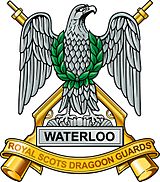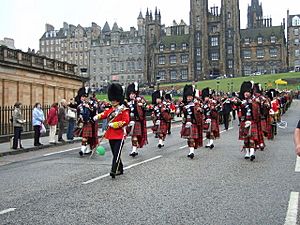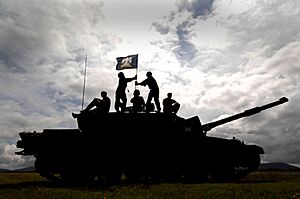Royal Scots Dragoon Guards facts for kids
Quick facts for kids The Royal Scots Dragoon Guards(Carabiniers and Greys) |
|
|---|---|

Cap badge of the Royal Scots Dragoon Guards
|
|
| Active | 2 July 1971–Present |
| Country | |
| Branch | |
| Type | Line cavalry |
| Role | Light Cavalry |
| Size | One regiment |
| Part of | Royal Armoured Corps |
| Garrison/HQ | Home HQ – Edinburgh Castle Regiment – Waterloo Lines, Leuchars Station |
| Nickname(s) | Scotland's Cavalry |
| Motto(s) | Nemo me impune lacessit (No one provokes me with impunity) Ich Dien (I Serve) Second to None |
| March | Quick (band) – The 3DGs; (pipes & drums) – Hielan' Laddie Slow (band) – The Garb of Old Gaul; (pipes & drums) – My Home |
| Mascot(s) | Drum Horse (Talavera) |
| Anniversaries | 13 April (Nunshigum) 18 June (Waterloo) 25 October (Balaklava) |
| Commanders | |
| Colonel-in-Chief | HM The Queen |
| Insignia | |
| Tactical Recognition Flash |  |
| Arm Badge | Prince of Wales's feathers from 3rd Dragoon Guards (Prince of Wales's) |
| Tartan | Royal Stewart (Pipers kilts and plaids) |
| Abbreviation | SCOTS DG |
The Royal Scots Dragoon Guards (Carabiniers and Greys) is a special cavalry regiment in the British Army. It is known as the oldest surviving cavalry regiment in the British Army. This means it has a very long and proud history! Today, the regiment is based at Waterloo Lines, Leuchars Station in Scotland. They are part of a group called the 51st Infantry Brigade and Headquarters Scotland.
Contents
History of the Regiment
How the Regiment Was Formed
The Royal Scots Dragoon Guards were created on July 2, 1971. This happened in Holyrood, Edinburgh. Two older regiments joined together to form it:
- The 3rd Carabiniers (Prince of Wales's Dragoon Guards)
- The Royal Scots Greys (2nd Dragoons)
The 3rd Carabiniers themselves were formed in 1922 from two even older groups.
Early Operations and Challenges
Soon after forming, the regiment went on four tours to Northern Ireland. This was between 1972 and 1980. Sadly, one soldier, Trooper Ian Hunter Caie, died in 1972. He was killed by a bomb while in his scout car.
Serving in Major Conflicts
The regiment played an active role in the Gulf War in 1991. They used 57 Challenger tanks during this time. Later, they served in Bosnia from 1996 to 1997. In 1998, they were the first British Army regiment to use the Challenger 2 main battle tank. They also went to Kosovo in 2000.
The regiment was part of Operation Telic in Iraq in 2003. This was the British part of the 2003 invasion of Iraq. Most of the regiment advanced on Basra, Iraq's second-largest city. One squadron fought near Az Zubayr. Another squadron joined 3 Commando Brigade in battles south of Basra. This included a large tank battle where 14 Challenger 2 tanks destroyed 14 Iraqi tanks.
The regiment returned to Iraq in 2006 and 2008. They sadly lost two soldiers, Lieutenant Richard Palmer and Corporal Gordon Pritchard. More recently, they served in Afghanistan in 2008, 2011, and 2013-2014.
Musical Success and New Roles
The regiment's pipes and drums became famous. They won "Album of the Year" at the 2009 Classical Brits. Their album, Spirit of the Glen: Journey, was recorded while they were serving in Afghanistan.
In 2013, the regiment changed its role. They stopped using their Challenger 2 tanks. Instead, they became a Light Cavalry unit. They now use Jackal vehicles. In 2015, they moved to Leuchars Station. On September 29, 2015, Queen Elizabeth II visited Leuchars. She named part of the camp 'Waterloo Lines'. This was to celebrate 200 years since the Battle of Waterloo.
In 2017, the regiment went to Cyprus. They served with the United Nations as peacekeepers for six months.
How the Regiment is Organized Today
The Royal Scots Dragoon Guards are now a light cavalry unit. This change happened as part of the army's "Army 2020" plan. They use Jackal armoured fighting vehicles. They also work closely with the Scottish and North Irish Yeomanry. This is an Army Reserve light cavalry regiment.
The Royal Scots Dragoon Guards is made up of different parts:
- Regimental Headquarters: This is based at Edinburgh Castle.
- The Mounted Troop: This is a ceremonial unit also at Edinburgh Castle.
- Armoured Regiment Headquarters
- Headquarters Squadron: This group uses Coyote and Panther CLV vehicles.
- Pipes and Drums of the Royal Scots Dragoon Guards
- A Squadron: This group uses Jackal vehicles.
- B Squadron: This group uses Jackal vehicles.
- C Squadron: This group uses Jackal vehicles.
- Headquarters Squadron: This group uses Coyote and Panther CLV vehicles.
In the regiment, all soldiers with the rank of OR-2 are called 'Troopers'. This is a nod to their long history as a cavalry unit.
Regimental Museum
The Royal Scots Dragoon Guards Museum is located at Edinburgh Castle. It opened in 2006. In the museum, you can see uniforms, medals, weapons, and musical instruments. A special item is the French Imperial Eagle. This eagle was captured by Sergeant Charles Ewart during the Battle of Waterloo. He took it from the French 45th Regiment.
Uniform and Special Items
Cap Badge and Its Meaning
The regiment's cap badge shows an eagle. This eagle represents the French Imperial Eagle captured at the Battle of Waterloo. The badge is always worn with a black backing. This is a sign of mourning for Tsar Nicholas II. He was the last Tsar of Russia and the regiment's Colonel-in-Chief when he died. The cap badge also has the crossed carbines of the 3rd Carabiniers behind the eagle.
Prince of Wales's Plume
All members of the regiment wear The Plume of The Prince of Wales. It has the motto "Ich Dien" (I Serve). This badge is sewn onto the upper part of their left sleeve. The 3rd Dragoon Guards were given the right to wear this badge in 1765.
Distinctive Yellow Cap Band
The regiment has a unique yellow zigzag pattern on its cap band. This pattern is called "vandyke." It was inherited from the Royal Scots Greys, who had worn it since the mid-19th century.
Royal Stewart Tartan
As a royal regiment, the Royal Scots Dragoon Guards can wear the Royal Stewart tartan. This special privilege was given by King George VI. The regiment's pipers wear this tartan.
Regimental Mottos
The main regimental motto is Nemo Me Impune Lacessit. This means "No one provokes me with impunity." It is also the motto of the Order of the Thistle. The regiment also uses the motto "Second to None."
Special Traditions
At formal dinners, the regiment has a tradition called the Loyal Toast. They drink this toast while seated, unless a member of the Royal Family is present. If a military band is there, they play "The Queen." They also play "God Bless the Prince of Wales," a tradition from the old 3rd Dragoon Guards. Another tune played is the "Imperial Russian Anthem." This is to remember Tsar Nicholas II, who was the Colonel-in-Chief of the Scots Greys.
The regiment also has a mounted Drum Major. This person wears a special white bearskin hat. This hat was a gift from Tsar Nicholas during his time as Colonel of the Regiment.
Pipes and Drums

The regiment has its own pipe band. This band was first formed in 1946. They travel widely, performing in competitions, concerts, and parades. It was the first official pipe band in the regiment's history.
Their most famous song is "Amazing Grace." This song reached number one on the music charts in several countries in 1972. These included the United Kingdom, Ireland, Australia, New Zealand, Canada, and South Africa. The song sold over seven million copies. It was also featured in the 1978 movie Invasion of the Body Snatchers.
In 2007, the band released a new CD called Spirit of the Glen. It included classic pipe tunes and modern arrangements. This album was recorded while the regiment was in Iraq. Spirit of the Glen won "Album of the Year" at the 2009 Classical Brits. The band also often performs at the Royal Edinburgh Military Tattoo.
Regimental Band
After the new regiment was formed, the bands of the Scots and 3rd Dragoon Guards joined together. They became the Band of the Royal Scots Dragoon Guards. This band went with the regiment on all its operations, including the Gulf War.
Later, due to army changes in 1992, this band merged with others. It became the Band of the Dragoon Guards. The percussion section of this new band wore special uniforms. They had Bearskins with a large crimson plume and black pants with yellow stripes. This was a copy of the old Scots band's uniform. The Drum Major's uniform also had a black bearskin with a crimson plume and yellow pants.
In 2006, this band merged again to form the Heavy Cavalry and Cambrai Band. They kept the percussion uniforms. When the Band of the Royal Armoured Corps was formed, the bearskin cap was no longer used, but the black and yellow pants remained.
Alliances Around the World
The Royal Scots Dragoon Guards have special connections with other military units:
 Australia – 12th/16th Hunter River Lancers (Australia)
Australia – 12th/16th Hunter River Lancers (Australia) Canada – The Windsor Regiment (RCAC) (Canada)
Canada – The Windsor Regiment (RCAC) (Canada) South Africa – Ingobamakhosi Carbineers (South Africa)
South Africa – Ingobamakhosi Carbineers (South Africa) Royal Navy – HMS Vengeance (Royal Navy submarine)
Royal Navy – HMS Vengeance (Royal Navy submarine)
Affiliated Yeomanry
- Scottish and North Irish Yeomanry
Former Alliances
 New Zealand – The New Zealand Scottish Regiment (this regiment was disbanded in 2016)
New Zealand – The New Zealand Scottish Regiment (this regiment was disbanded in 2016)
Colonel-in-Chief
- 2 July 1971 – present: HM Queen Elizabeth II
Images for kids



